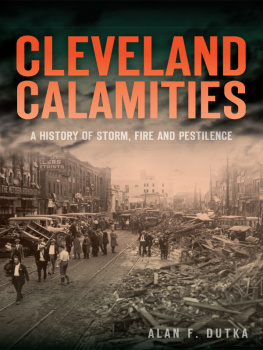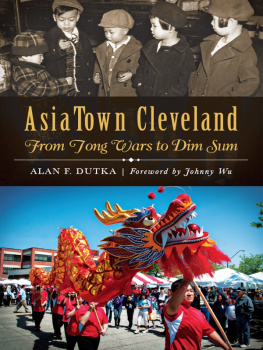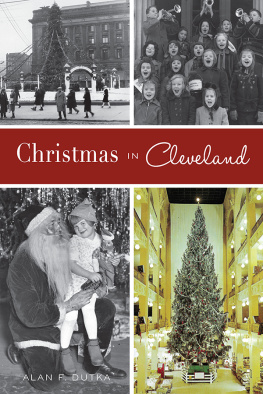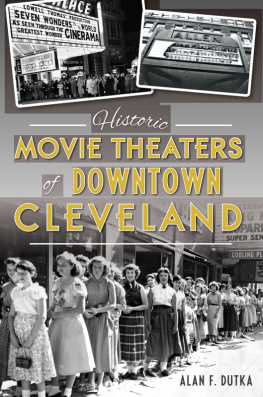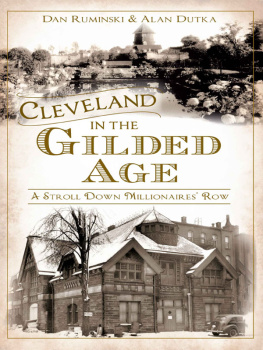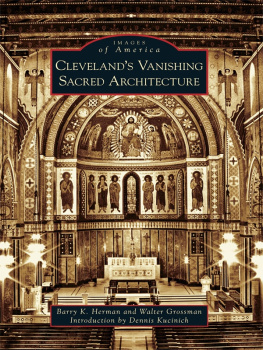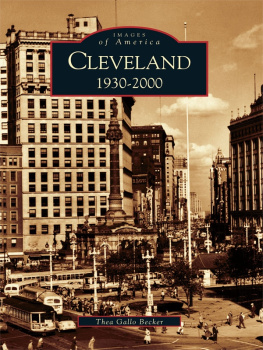Published by The History Press
Charleston, SC
www.historypress.net
Copyright 2017 by Alan F. Dutka
All rights reserved
Front cover, top: courtesy of Special Collections, Michael Schwartz Library, Cleveland State University; bottom: courtesy of St. Clair Superior Development Corporation.
First published 2017
e-book edition 2017
ISBN 978.1.43966.275.5
Library of Congress Control Number: 2017940954
print edition ISBN 978.1.62585.974.7
Notice: The information in this book is true and complete to the best of our knowledge. It is offered without guarantee on the part of the author or The History Press. The author and The History Press disclaim all liability in connection with the use of this book.
All rights reserved. No part of this book may be reproduced or transmitted in any form whatsoever without prior written permission from the publisher except in the case of brief quotations embodied in critical articles and reviews.
Foreword
Cleveland author Alan Dutka provides a glimpse into the lives of some of Cleveland Slovenians most intriguing, inspiring and tragic stories. Dutka has been writing about hidden pieces of Cleveland history for over a decade, including his books on Clevelands AsiaTown, Clevelands Millionaires Row, East Fourth Street, Short Vincent, downtown movie theaters and some of the darker days in the citys history in Cleveland Calamities.
Dutka, who grew up in the shadow of Clevelands Industrial Valley and the factories and mills that employed many Slovenian immigrants, dives into the subject by exploring the lives and struggles of the areas first Slovenians in the late ninetieth century and follows several waves of immigrants through the twentieth century and into the present century. Like many immigrant groups, Slovenians survived and prospered by banding together to form and build their own churches, social halls and businesses, all of which were staples in the daily life of these ethnic enclaves. Cleveland is home to eight Slovenian national homes, venues that play a key role in the northeast Ohio community by hosting weddings, parties, concerts, political rallies and other social events.
Cleveland, home to the largest population of Slovenian people outside of Slovenia, has several historically Slovenian neighborhoods, including St. Clair, Collinwood and Newburgh. These close-knit communities provided generations of Slovenians with social networks, recreation, religion, education, arts and culture, as well as a unique culinary environment where traditional recipes and food have lived on through generations. The role these neighborhoods played in shaping the history of Cleveland cannot be understated.
Though many Slovenians have moved from the old neighborhoods into the suburbs and exurbs, the national homes are still considered important social hubs for the community. They continue to be anchors for these neighborhoods as residents put the pieces back together after the foreclosure crisis of 200812. An affinity for the history of these neighborhoods has captivated a younger generation and has given rise to a number of new events, including the annual Kurentovanje festival, held in the St. Clair neighborhood. It attracts thousands of people to the area to experience Slovenian culture.
In this book, Dutka provides entertaining information and stories that give a glimpse into what life was like for Clevelands Slovenians in the last 135 years. Life wasnt always easy, and there have been plenty of challenges along the way. But with each challenge came an opportunity for accomplishmentas you will read, there have certainly been many accomplishments, and many more are yet to come.
James Amendola
Industrial/Commercial Manager,
St. Clair Superior Development Corporation
Foreword
Growing up a third-generation Slovenian in Slavic Village (Newburgh), Cleveland, I have been hanging out at the Slovenian National Home (the Nash) on East Eightieth Street my entire life. My grandfather is a past president of the organization, and his leadership in the Slavic Village community has been an inspiration such that my own neighborhood development company, Sonny Day, bears his nickname.
I became actively involved at the Nash in 2011 as director of development, with the goal of helping the aging yet resilient organization continue to enjoy its fraternal activities while revitalizing and preserving the use of its historic property. Since that time, I have had countless questions for my grandfather (who passed away in 2006) regarding the beautiful, one-hundred-year-old, hand-built social hall and the fraternal aspects of the organization, along with its relationship with the other, now-century-old Slovenian Homes throughout Cleveland. Truly, if walls could talk.
In this book, Alan Dutka answers many of the questions Ive had over the years (except Why is the hall painted so pink? and Why are there so many pairs of size nines in the Lanes?), and he paints a comprehensive picture of the Slovenian culture from a palette filled by way of exploring his own, genuine curiosity. Ive had the pleasure to spend some time with the author, sharing only my point of view; his genuine nature rings true here in print, recalling conversations and interviews throughout the Cleveland Slovenian community.
Its remarkable to ponder how these immigrants were able to build these National Homes a century ago, especially with the backdrop of the economic and other challenges highlighted in this book. Its even more remarkable to consider these Slovenes as only one of the many immigrant groups pursuing a similar happiness in America and building this diverse city of Cleveland despite facing similar challenges.
The bonds madegalvanized by the wars, the Great Depression and beyondhave been celebrated for generations in these social halls. Its part of the rich history that one cannot describe but can only feel when standing inside the magnificent structures. Dutka provides the context for the importance of preserving this existing fabric and honoring the past as we plan for the future.
For me, many of the recalled names, places and events ring a bell. Whether or not they do for the reader, the spirit of fraternity, tenacity and love is something we can all relate to. Its a charming grit.
Na Zdravje!
Anthony J. Trzaska
Director of Development, Slovenian National Home (Newburgh)
Founder, Sonny Day Development Corporation
Preface
Although I have an abundance of ethnic blood flowing though my veins, I doubt if a DNA test would reveal any consequential Slovenian heritage. Nonetheless, I consider myself sort of an honorary Slovenian. I attended the same high school as students whose Slovenian parents had remained in Clevelands very first Slovenian enclave. By the time I had become a teenager, rock n roll had generally relegated polka music to a non-hip status, enjoyed only by old people in their thirties or older. But in the neighborhood where I grew up, teenagers still enthusiastically purchased the latest Frankie Yankovic polka albums at the Fleet Avenue record store.
Furthermore, for the past forty years, I have been married to a 100 percent Slovenian woman. Eating my mother-in-laws potica and krofe became enjoyable experiences, and even listening to my father-in-laws Sunday afternoon selection of radio stations playing Cleveland-style polkas had its redeeming moments. Therefore, although I knew I had a lot of learning ahead of me, I felt comfortable researching and writing a story about Clevelands Slovenians. And I received an amazing amount of assistance within the Slovenian communities. A priest opened his rectory door, and a butcher unlocked his smokehouse. Residents supplied pictures, and a historian warned me of potential problems in interpreting past events.


